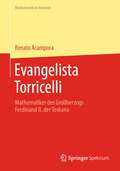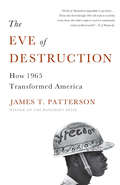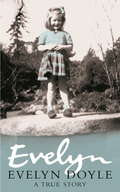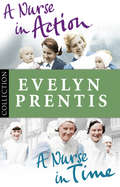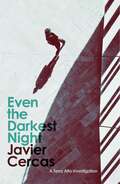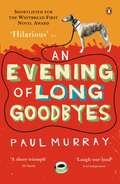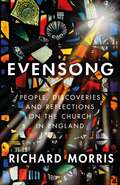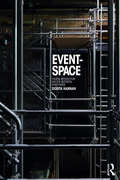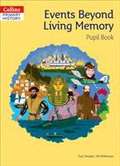- Table View
- List View
Evangelista Torricelli: Mathematiker des Großherzogs Ferdinand II. der Toskana (Mathematik im Kontext)
by Renato AcamporaDie meisten Nichtmathematiker werden Torricelli durch das nach ihm benannte Ausflussgesetz kennen, wonach die Geschwindigkeit eines aus einem Gefäss austretenden Wasserstrahls proportional zur Quadratwurzel aus der Füllhöhe ist, ebenso wie durch seinen Nachweis des Luftdrucks mithilfe seines Vakuumexperiments. Viel bedeutender aber sind seine Leistungen auf dem Gebiet der Mathematik als virtuoser Vertreter von Cavalieris umstrittener Indivisiblenmethode, wobei er seine Ergebnisse aber stets mit Beweisen nach der allgemein anerkannten „Art der Alten“ absicherte. Auf diese Weise gelang ihm die Quadratur der Parabeln und Hyperbeln höherer Ordnung, der Zykloide, der logarithmischen Spirale (ebenso wie deren Rektifikation) und die Bestimmung der Schwerpunkte zahlreicher ebener und räumlicher Figuren.
Evangelizing the South: A Social History of Church and State in Early America (Religion in America)
by Monica NajarAlthough many refer to the American South as the "Bible Belt", the region was not always characterized by a powerful religious culture. In the seventeenth century and early eighteenth century, religion-in terms both of church membership and personal piety-was virtually absent from southern culture. The late eighteenth century and early nineteenth century, however, witnessed the astonishingly rapid rise of evangelical religion in the Upper South. Within just a few years, evangelicals had spread their beliefs and their fervor, gaining converts and building churches throughout Virginia and North Carolina and into the western regions. But what was it that made evangelicalism so attractive to a region previously uninterested in religion? Monica Najar argues that early evangelicals successfully negotiated the various challenges of the eighteenth-century landscape by creating churches that functioned as civil as well as religious bodies. The evangelical church of the late eighteenth century was the cornerstone of its community, regulating marriages, monitoring prices, arbitrating business, and settling disputes. As the era experienced substantial rifts in the relationship between church and state, the disestablishment of colonial churches paved the way for new formulations of church-state relations. The evangelical churches were well-positioned to provide guidance in uncertain times, and their multiple functions allowed them to reshape many of the central elements of authority in southern society. They assisted in reformulating the lines between the "religious" and "secular" realms, with significant consequences for both religion and the emerging nation-state. Touching on the creation of a distinctive southern culture, the position of women in the private and public arenas, family life in the Old South, the relationship between religion and slavery, and the political culture of the early republic, Najar reveals the history behind a religious heritage that remains a distinguishing mark of American society.
Evariste Galois 1811–1832 (Vita Mathematica #11)
by Laura Toti RigatelliEvariste Galois' short life was lived against the turbulent background of the restoration of the Bourbons to the throne of France, the 1830 revolution in Paris and the accession of Louis-Phillipe. This new and scrupulously researched biography of the founder of modern algebra sheds much light on a life led with great intensity and a death met tragically under dark circumstances. Sorting speculation from documented fact, it offers the fullest and most exacting account ever written of Galois' life and work. It took more than seventy years to fully understand the French mathematician's first mémoire (published in 1846) which formulated the famous "Galois theory" concerning the solvability of algebraic equations by radicals, from which group theory would follow. Obscurities in his other writings - mémoires and numerous fragments of extant papers - persist and his ideas challenge mathematicians to this day. Thus scholars will welcome those chapters devoted specifically to explicating all aspects of Galois' work. A comprehensive bibliography enumerates studies by and also those about the mathematician.
Eve: How The Female Body Drove 200 Million Years of Human Evolution (Longlisted for the Women's Prize for Non-Fiction)
by Cat BohannonA NEW YORK TIMES BESTSELLERLONGLISTED FOR THE WOMEN'S PRIZE FOR NON-FICTION 2024FOYLE'S NON-FICTION BOOK OF THE YEAR 2023LONGLISTED FOR BLACKWELL'S NON-FICTION BOOK OF THE YEAR 2023ONE OF THE GUARDIAN'S BEST IDEAS BOOKS OF 2023ONE OF THE TELEGRAPH'S FIFTY BEST BOOKS OF 2023ONE OF PROSPECT'S BOOKS OF THE YEAR 2023ONE OF DUA LIPA'S SERVICE95 RECOMMENDATIONS FOR '5 INSPIRING READS TO KICK START THE NEW YEAR''Funny and very important' Chris van Tulleken, bestseling author of Ultra-Processed People'Educates and emboldens' Bonnie Garmus, bestselling author of Lessons in Chemistry'Should revolutionise our understanding of human life' George Monbiot, bestselling author of Regenesis'A vast and revolutionary history of female evolution' Sunday TimesHow did wet nurses drive civilization? Are women always the weaker sex? Is sexism useful for evolution? And are our bodies at war with our babies?In Eve, Cat Bohannon answers questions scientists should have been addressing for decades. With boundless curiosity and sharp wit, she covers the past 200 million years to explain the specific science behind the development of the female sex. Eve is not only a sweeping revision of human history, it's an urgent and necessary corrective for a world that has focused primarily on the male body for far too long. Bohannon's findings, including everything from the way C-sections in the industrialized world are rearranging women's pelvic shape to the surprising similarities between pus and breast milk, will completely change what you think you know about evolution and why Homo sapiens have become such a successful and dominant species, from tool use to city building to the development of language.
The Eve of Destruction: How 1965 Transformed America
by James T. Pattersone much more staid recordings of contemporary acts like Frank Sinatra, Julie Andrews, and the Supremes, reflecting an alienation from mainstream American culture shared by an increasing number of young Americans. In The First Year of the Sixties, James T. Patterson traces the transformative events of this critical year, showing how 1965 saw an idealistic and upbeat nation derailed by developments both at home and abroad. An entire generation of Americans—as well as the country&’s politics, culture, race relations, and foreign policies—would never be the same.
The Eve of Spain: Myths of Origins in the History of Christian, Muslim, and Jewish Conflict
by Patricia E. GrieveThe Eve of Spain demonstrates how the telling and retelling of one of Spain’s founding myths played a central role in the formation of that country’s national identity. King Roderigo, the last Visigoth king of Spain, rapes (or possibly seduces) La Cava, the daughter of his friend and counselor, Count Julian. In revenge, the count travels to North Africa and conspires with its Berber rulers to send an invading army into Spain. So begins the Muslim conquest and the end of Visigothic rule. A few years later, in Northern Spain, Pelayo initiates a Christian resistance and starts a new line of kings to which the present-day Spanish monarchy traces its roots.Patricia E. Grieve follows the evolution of this story from the Middle Ages into the modern era, as shifts in religious tolerance and cultural acceptance influenced its retelling. She explains how increasing anti-Semitism came to be woven into the tale during the Christian conquest of the peninsula—in the form of traitorous Jewish conspirators. In the sixteenth century, the tale was linked to the looming threat of the Ottoman Turks. The story continued to resonate through the Enlightenment and into modern historiography, revealing the complex interactions of racial and religious conflict and evolving ideas of women’s sexuality.In following the story of La Cava, Rodrigo, and Pelayo, Grieve explains how foundational myths and popular legends articulate struggles for national identity. She explores how myths are developed around few historical facts, how they come to be written into history, and how they are exploited politically, as in the expulsion of the Jews from Spain in 1492 followed by that of the Moriscos in 1609. Finally, Grieve focuses on the misogynistic elements of the story and asks why the fall of Spain is figured as a cautionary tale about a woman’s sexuality.
The Eve of Spain: Myths of Origins in the History of Christian, Muslim, and Jewish Conflict
by Patricia E. GrieveThe Eve of Spain demonstrates how the telling and retelling of one of Spain’s founding myths played a central role in the formation of that country’s national identity. King Roderigo, the last Visigoth king of Spain, rapes (or possibly seduces) La Cava, the daughter of his friend and counselor, Count Julian. In revenge, the count travels to North Africa and conspires with its Berber rulers to send an invading army into Spain. So begins the Muslim conquest and the end of Visigothic rule. A few years later, in Northern Spain, Pelayo initiates a Christian resistance and starts a new line of kings to which the present-day Spanish monarchy traces its roots.Patricia E. Grieve follows the evolution of this story from the Middle Ages into the modern era, as shifts in religious tolerance and cultural acceptance influenced its retelling. She explains how increasing anti-Semitism came to be woven into the tale during the Christian conquest of the peninsula—in the form of traitorous Jewish conspirators. In the sixteenth century, the tale was linked to the looming threat of the Ottoman Turks. The story continued to resonate through the Enlightenment and into modern historiography, revealing the complex interactions of racial and religious conflict and evolving ideas of women’s sexuality.In following the story of La Cava, Rodrigo, and Pelayo, Grieve explains how foundational myths and popular legends articulate struggles for national identity. She explores how myths are developed around few historical facts, how they come to be written into history, and how they are exploited politically, as in the expulsion of the Jews from Spain in 1492 followed by that of the Moriscos in 1609. Finally, Grieve focuses on the misogynistic elements of the story and asks why the fall of Spain is figured as a cautionary tale about a woman’s sexuality.
Eve Tempted: Writing and Sexuality in Hawthorne's Fiction (Routledge Library Editions: The Nineteenth-Century Novel)
by Allan Gardner Lloyd SmithFirst published in 1984, this book offers a unique interpretation of Hawthorne’s work, making use of perspectives opened up by Derrida in his work on Rousseau. It offers a psycho-biography of the author as discoverable in the texts and avoids a simplistic Freudian analysis. In doing so, it illuminates the work and re-opens Hawthorne’s texts to creative discussion. This book will be of interest to those studying 19th century literature.
Eve Tempted: Writing and Sexuality in Hawthorne's Fiction (Routledge Library Editions: The Nineteenth-Century Novel)
by Allan Gardner Lloyd SmithFirst published in 1984, this book offers a unique interpretation of Hawthorne’s work, making use of perspectives opened up by Derrida in his work on Rousseau. It offers a psycho-biography of the author as discoverable in the texts and avoids a simplistic Freudian analysis. In doing so, it illuminates the work and re-opens Hawthorne’s texts to creative discussion. This book will be of interest to those studying 19th century literature.
Evelyn: A True Story
by Evelyn DoyleTold through the eyes of his daughter Evelyn, this is the true story of a father's fight to reclaim his children from the Irish government in the 1950s, now a major film.Desmond Doyle, 29, a painter and decorator, is married with six children and living in the infamous Fatima Mansions in Dublin in 1953. One day he comes home to find his wife has left him. He decides to go to England to find work and is advised to put his children into the state Industrial Schools system for a short time until he returns. When he returns he is told to his horror that the children have been consigned to the state until they are 16. This is the story of how Desmond Doyle fought the Irish legal system to change the law and win back his family.
Evelyn Prentis Bundle: A Nurse in Time/A Nurse in Action
by Evelyn PrentisDesperate circumstances were something Evelyn Prentis had to get very used to when she began her life as a nurse. It was in 1934 that Evelyn left home for the first time to enrol as a trainee at a busy Nottingham hospital in the hope of £25 a year. A Nurse in Time is Evelyn's affectionate and funny account of those days of dedication and hardship, when never-ending nightshifts, strict Sisters and permanent hunger ruled life, and joy was to be found in a late-night pass and a packet of Woodbines.The second memoir in this collection is A Nurse in Action. Surprising Matron as well as herself, Evelyn Prentis managed to pass her Finals and become a staff-nurse. Encouraged, she took the brave leap of moving from Nottingham to London - brave not least because war was about to break. Not only did the nurses have to cope with stray bombs and influxes of patients from as far away Dunkirk, but there were also RAF men stationed nearby - which caused considerable entertainment and disappointment, and a good number of marriages ...But despite all the disruption to the hospital routine, Evelyn's warm and compelling account of a nurse in action, shows a nurse's life would always revolve around the comforting discomfort of porridge and rissoles, bandages and bedpans.
Even More Merseyside Tales!: Curious and Amazing True Tales from History
by Ken PyeIn Ken Pye's third collection of strange and often bizarre tales from Merseyside’s History, prepare to be amazed and entertained, once again.Where on Merseyside was the nonsense rhyme, ‘The Owl and The Pussycat’ written? How did the 'Cast Iron Shore’ or the Cazzie get its name? Is there a lost street running beneath Lime Street?Learn about 'Roast Beef’ the Crosby Hermit, the prehistoric footprints on Formby Shore, and the particularly intimate wax models of diseased body parts found in the Paradise Street Museum of Anatomy. There are over fifty such true stories and secret wonders in this amazingly eclectic book, but consider yourself warned – once you begin reading these tales you might find it hard to stop!
Even the Darkest Night: A Terra Alta Investigation
by Javier CercasA Melchor Marín novel. Winner of Spain's biggest literary prize - the Premio PlanetaWhen Melchor goes to investigate the horrific double-murder of a rich printer and his wife in rural Cataluña nothing quite adds up. The young cop from the big city, hero of a foiled terrorist attack, has been sent to Terra Alta till things quieten down. Observant, streetwise and circumspect, Melchor is also an outsider.The son of a Barcelona prostitute who never knew his father, Melchor rapidly fell into trouble and was jailed at 19, convicted of driving for a Colombian drug cartel. While he was behind bars, he read Hugo's Les Misérables, and then his mother was murdered. Admiring of both Jean Valjean and Javert - but mostly the relentless Javert - he decided to become a policeman.Now he is out for revenge, but he can wait, and meanwhile he has discovered happiness with his wife, the local librarian, and their daughter, who is, of course, called Cossette.Slowly at first, and then more rapidly once ordered to abandon the case, he tracks the clues that will reveal the larger truth behind what appears at first to be a cold-blooded, professional killing.Translated from the Spanish by Anne McLean
Even to the Edge of Doom: A Love that Survived the Holocaust
by William Schiff Rosalie SchiffIn 1943 William and Rosalie Schiff, newly married in the Krakow Ghetto, were forcibly separated and sent on individual journeys through a 'surreal maze of hate'. Saved by the legendary Oscar Schindler, they were reunited at the Plaszow work camp, where they were at the mercy of the bestial SS commandant Amon Goth. When Rosalie was shipped out for a work detail at another camp, William stowed away on a train, desperate to catch up with her; but the train took him to the notorious Auschwitz death camp. Even to the Edge of Doom tells the story of two young people who stayed alive against all the odds to find one another again.
The Evening and the Morning: The Prequel to The Pillars of the Earth, A Kingsbridge Novel (Kingsbridge Ser. #4)
by Ken FollettFrom the bestselling author Ken Follett, The Evening and the Morning is a historical epic that will end where The Pillars of the Earth begins.A TIME OF CONFLICTIt is 997 CE, the end of the Dark Ages, and England faces attacks from the Welsh in the west and the Vikings in the east. Life is hard, and those with power wield it harshly, bending justice according to their will – often in conflict with the king. With his grip on the country fragile and with no clear rule of law, chaos and bloodshed reign.THREE LIVES INTERTWINEDInto this uncertain world three people come to the fore: a young boatbuilder, who dreams of a better future when a devastating Viking raid shatters the life that he and the woman he loves hoped for; a Norman noblewoman, who follows her beloved husband across the sea to a new land only to find her life there shockingly different; and a capable monk at Shiring Abbey, who dreams of transforming his humble abbey into a centre of learning admired throughout Europe.THE DAWN OF A NEW AGENow, with England at the dawn of the Middle Ages, these three people will each come into dangerous conflict with a ruthless bishop, who will do anything to increase his wealth and power, in an epic tale of ambition and rivalry, death and birth, and love and hate.Thirty years ago we were introduced to Kingsbridge in The Pillars of the Earth, and now in this masterful prequel international bestseller Ken Follett will take us on a journey into a rich past, which will end where his masterpiece begins.
Evening in the Palace of Reason: Bach Meets Frederick The Great In The Age Of Enlightenment
by James GainesIn one corner, a godless young warrior, Voltaire’s heralded ‘philosopher-king’, the It Boy of the Enlightenment. In the other, a devout if bad-tempered old composer of ‘outdated’ music, a scorned genius in his last years. The sparks from their brief conflict illuminate a turbulent age.
An Evening of Long Goodbyes: A Novel
by Paul MurrayAcclaimed as one of the funniest and most assured Irish novels of recent years, An Evening of Long Goodbyes is the story of Dubliner Charles Hythloday and the heroic squandering of the family inheritance. Featuring drinking, greyhound racing, vanishing furniture, more drinking, old movies, assorted Dublin lowlife, eviction and the perils of community theatre, Paul Murray's debut novel is a tour de force of comedic writing wrapped in an honest-to-goodness tale of a man- and a family - living in denial . . .
The Evening Road
by Laird HuntMeet Ottie Lee Henshaw. Quick of mind and pleasing to the eye, she navigates a stifling marriage, a lecherous boss, and on one day in the summer of 1920, an odyssey across the countryside to witness a dark and fearful celebration.Meet Calla Destry. A young black woman desperate to escape a place where the stench of violence hangs heavy in the air, and to find the lover who has promised her a new life.Two remarkable women on the move through an America riven by fear and hatred. Every road leads to the bedlam of Marvel. There are buses laid on and Klan members gathering. Lives will collide and be changed forever.
Evensong: People, Discoveries and Reflections on the Church in England
by Richard MorrisParish churches have been at the heart of communities for more than a thousand years. But now, fewer than two in one hundred people regularly attend services in an Anglican church, and many have never been inside one. Since the idea of 'church' is its people, the buildings are becoming husks - staples of our landscapes, but without meaning or purpose. Some churches are finding vigorous community roles with which to carry on, but the institutional decline is widely seen as terminal.Yet for Richard Morris, post-war parsonages were the happy backdrop of his childhood. In Evensong he searches for what it was that drew his father and hundreds like him towards ordination as they came home from war in 1945. Along the way we meet all kinds of people - archbishops, chaplains, campaigners, bell-ringers, bureaucrats, archaeologists, gravediggers, architects, scroungers - and follow some of them to dark places.Part personal odyssey, part lyrical history, Evensong asks what churches stand for and what they can tell us; it explores why Anglicanism has often been fractious, and why it has become so diffuse. Spanning over two thousand years, it draws on new discoveries, reflects on the current state of the Church in England and ends amid the messy legacies of colonialism and empire.
Event-Space: Theatre Architecture and the Historical Avant-Garde
by Dorita HannahAs the symbolists, constructivists and surrealists of the historical avant-garde began to abandon traditional theatre spaces and embrace the more contingent locations of the theatrical and political ‘event’, the built environment of a performance became not only part of the event, but an event in and of itself. Event-Space radically re-evaluates the avant garde’s championing of nonrepresentational spaces, drawing on the specific fields of performance studies and architectural studies to establish a theory of ‘performative architecture’. ‘Event’ was of immense significance to modernism’s revolutionary agenda, resisting realism and naturalism – and, simultaneously, the monumentality of architecture itself. Event-Space analyzes a number of spatiotemporal models central to that revolution, both illuminating the history of avant-garde performance and inspiring contemporary approaches to performance space.
Event-Space: Theatre Architecture and the Historical Avant-Garde
by Dorita HannahAs the symbolists, constructivists and surrealists of the historical avant-garde began to abandon traditional theatre spaces and embrace the more contingent locations of the theatrical and political ‘event’, the built environment of a performance became not only part of the event, but an event in and of itself. Event-Space radically re-evaluates the avant garde’s championing of nonrepresentational spaces, drawing on the specific fields of performance studies and architectural studies to establish a theory of ‘performative architecture’. ‘Event’ was of immense significance to modernism’s revolutionary agenda, resisting realism and naturalism – and, simultaneously, the monumentality of architecture itself. Event-Space analyzes a number of spatiotemporal models central to that revolution, both illuminating the history of avant-garde performance and inspiring contemporary approaches to performance space.
Events Beyond Living Memory Pupil Book (PDF)
by Sue Temple Alf WilkinsonCollins Primary History provides a rich coverage of the Primary National Curriculum for History. Packed with information, source materials, questions and activities, the beautifully designed pupil books support children to explore, interpret and develop knowledge of significant historical periods. The accompanying Teacher’s Guide provides planning support and guidance on making progress in history.
Events That Changed America in the Eighteenth Century (The Greenwood Press "Events That Changed America" Series)
by John E. Findling Frank W. ThackerayDesigned to help students better understand the vitally important historical events of 18th century American history, this volume in the acclaimed series presents 10 major events in separate chapters. From the Great Awakening early in the century to Jefferson's Revolution of 1800, each chapter goes beyond the traditional textbook treatment of history by considering the immediate and far-reaching ramifications of each event. Events covered are: The Great Awakening, The Era of Salutary Neglect, The French and Indian War, The Stamp Act, The Boston Tea Party, The Declaration of Independence, The American Revolution, The Constitutional Convention, The XYZ Affair, and The Revolution of 1800.Each chapter features an introductory essay that presents the facts of the event, followed by an interpretive essay that places the event in a broader context and promotes student analysis. The introductory essay provides factual material in a clear, concise, chronological manner that makes complex history understandable. The interpretive essay, written by a recognized authority in the field and written in a style designed to appeal to a general readership, assesses the event in terms of its political, economic, sociocultural, and international/diplomatic significance. With its emphasis on factual details and interpretive analysis, an illustration, and an annotated bibliography for each event, a glossary of names, events, and terms of the period, a timeline of important events in eighteenth-century history, and a table of the population of the colonies and selected colonial towns, Events That Changed America in the Eighteenth Century is an ideal addition to the high school, community college, and undergraduate reference shelf, as well as excellent supplementary reading in social studies and American history courses.
Events That Changed America Through the Seventeenth Century (The Greenwood Press "Events That Changed America" Series)
by John E. Findling Frank W. ThackerayFrom the settlement of the earliest peoples in the Americas to the close of the seventeenth century, enormous changes took place in what was to become the continental United States. To help students understand this sweep of history, this unique resource provides detailed description and expert analysis of the ten most important events through the seventeenth century: First Encounters, c. 40,000 BCE - 1492 AD; The Expedition of Coronado, 1540-1542; The Founding of St. Augustine, 1565; Early English Colonization Efforts, c. 1584-1630; Early European-Native American Encounters, 1607-1637; The Introduction of Slavery into America, 1619; The Surrender of New Amsterdam, 1664; King Philip's War, 1675-1676; The Glorious Revolution in America, 1688-1689; and The Salem Witch Trials, 1692. Each event is dealt with in a separate chapter. The examination goes beyond traditional textbook treatment of history by considering the immediate and far-reaching ramifications of each event. Each chapter features an introductory essay that presents the facts of the event in a clear, chronological manner that makes complex history understandable. This essay is followed by an interpretive essay, written by a recognized authority in the field in a style designed to appeal to a general readership and promote critical thinking, that places the event in a broader context and assesses it in terms of its political, economic, sociocultural, and international significance.With an illustration and an annotated bibliography for each event, a glossary of names, events, and terms of the period, a timeline of important events in American history through the seventeenth century, Events That Changed America Through the Seventeenth Century is an ideal addition to the high school, community college, and undergraduate reference shelf, as well as excellent supplementary reading in social studies and American history courses.
